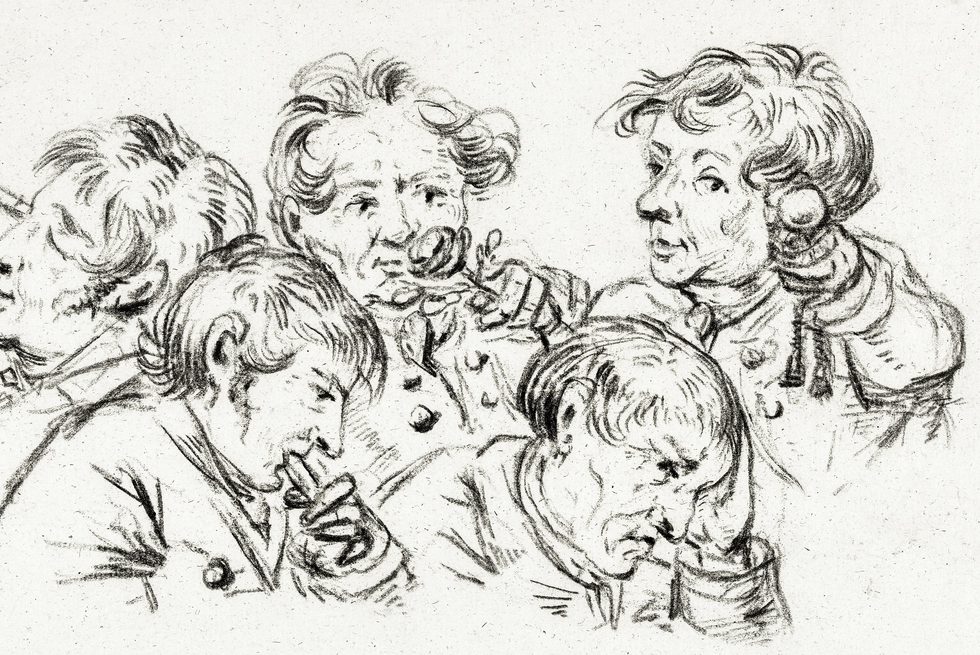
Scientific inquiry eschews and embraces sensory experience. Yet sight, sound, touch, smell, taste, and movement all inform scientific work. Across disciplines, bodies—scientists’ bodies, citizens’ bodies, participants’ bodies—are instruments. As Natasha Myers (2015, 204) puts it, bodies are “resources for learning the fine structures of complex . . . forms.”
Scientific knowledge-making practices that engage the senses—those of sensory science, for example—insist that researchers decontextualize and desocialize the sensorial process. Laboratory conditions, proponents argue, are necessary to understand and quantify how tasting or smelling is done. You like wine? Let us serve it to you through a small door in the wall. Similarly, chemistry, biology, computer science, and even engineering notoriously write the mediation of the senses out of scientific work. But neither scientists, no matter how pure their science, nor the people and things they study live in sensorial vacuums. How, then, to account for the role of the senses in the work of science?
Despite the role that the body and its senses play in expert practices of research, sensory information—be it gained, stored, mediated, or communicated through the body—remains suspect. The tacit nature of such information doesn’t help; difficult to capture and to assess, its role remains uncertain at best. “To accept sensuous scholarship,” notes Paul Stoller (1997, xvii), “is to eject the conceit of control in which mind and body, self and other are considered separate.” Stoller’s suggestion, counter to the tenets of scientific objectivity, highlights the central problem addressed by this Correspondences series: mapping, acknowledging, measuring, and respecting sensorial experience remains contested work in the practice of science.
Unique among the disciplines, anthropology has a long tradition of attending to sensorial experience. The anthropological work of observing inescapably and explicitly entails being affected; the authoring anthropologist must register the effects on the body of being elsewhere. Some scholars in science and technology studies take this being-affected of the anthropologist as a model for the scientist’s relationship to her research practices more generally; they argue that the body, again as instrument, is always an element in the scientific equation (Latour 2004; see also Muniesa and Trébuchet-Breitwiller 2010).
Yet much remains to be explored here. Anthropologists do not always or necessarily address the senses as a serious and systematic object of study, including in their own practices of knowledge-making. A paucity of tools for engaging the senses as “topics of ethnographic analysis or of theoretical development” (Sutton 2010, 210), complicated by scientists’ reticence to acknowledge their own “body experiments” (Myers 2015, 1), makes the capture of sensorial experience a challenge, even as anthropologists acknowledge its importance.
The contributors to this session of Correspondences contemplate opportunities for engaging the senses and their inevitable shortcomings, drawing on work by a range of anthropologists. We question and develop methodologies that explicitly account for the sensorial, insisting on taking the senses seriously. We ask what resources anthropology offers as its sensibilities enter sites of knowledge production such as the lab, the field site, or the built environment. More specifically, we ask, what tools does anthropology have in its toolkit for capturing and communicating the ineffable, ephemeral, individual practices of smelling, tasting, touching, and experiencing? We are interested in how anthropology can help to chart the ways in which the sensorial realm shapes the material relations of which scientific and other knowledge-making practices are made.
References
Latour, Bruno. 2004. “How to Talk about the Body? The Normative Dimension of Science Studies.” Body and Society 10, nos. 2–3: 205–229.
Muniesa, Fabian, and Anne-Sophie Trébuchet-Breitwiller. 2010. “Becoming a Measuring Instrument: An Ethnography of Perfume Consumer Testing.” Journal of Cultural Economy 3, no. 3: 321–37.
Myers, Natasha. 2015. Rendering Life Molecular: Models, Modelers, and Excitable Matter. Durham, N.C.: Duke University Press.
Stoller, Paul. 1997. Sensuous Scholarship. Philadelphia: University of Pennsylvania Press.
Sutton, David. 2010. “Food and the Senses.” Annual Review of Anthropology 39: 209–23.
Posts in This Series

Science and the Senses: Perturbation
I vividly remember how, on certain nights in my childhood, my brother and I would be herded toward the entrance hall of my parents’ house, where the Carl Zeiss ... More

Science and the Senses: Betrayal
Taking up the invitation to engage with the senses, several paths are already evoked in the introduction to this session written by Marianne de Laet and Christy... More

Science and the Senses: Deviation
The cerebral comedian Steven Wright tells an anecdote about meeting a woman in a bar, who fends off his advances by criticizing his mismatched footwear. “She sa... More

Science and the Senses: Integration
In our introduction to this session of Correspondences, we invited our participants—all scholars who work at the intersection of anthropology and the study of s... More